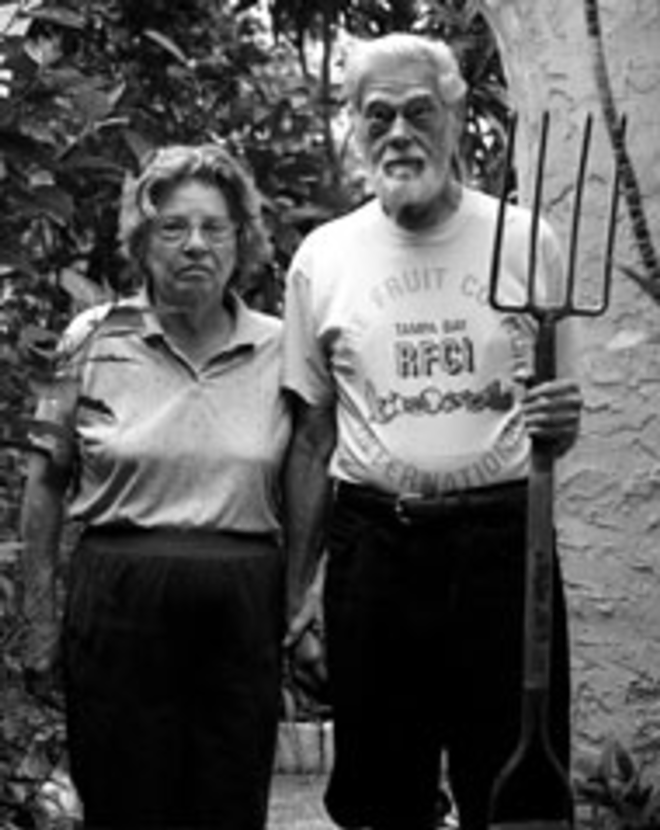If you are what you eat, then Bob and Theresa Heath are indeed rare creatures.For example, how many people do you know who count carambola as a regular part of their diet? The five-lobed carambola is also called "star fruit" because of the shape of its slices, and the Heaths grow and eat it in abundance. "It just doesn't know when to quit," says Bob, pointing out the tiny pinkish flowers sprouting on the tree limbs. The blooms sometimes grow so profusely that they blanket the ground when they fall. "And it flowers while it still has fruit."
Sure enough, each tree — and there are several — has fruit in various stages of ripeness as well as plenty of blossoms. "It doesn't taste like a tomato," he says, "but it has that same kind of sweet and tart flavor." So he uses it much like a tomato, putting it in salads and sandwiches with mayonnaise and sometimes onion. "I've got too many carambolas," he admits with a sigh that implies he might be just the tiniest bit sick of carambola sandwiches. But that's OK; there's plenty more to eat in the garden: pads of the nopales cactus, taro root, figs, sugar apples, bananas, tamarind, persimmons and more.
The Heaths started growing rare fruit 25 years ago when they joined the Miami Rare Fruit Council. "Before that, we had citrus and avocado, like everybody else," says Bob. Not long afterward, they became charter members of the Tampa Bay Rare Fruit Council, and now their south Tampa yard is a veritable jungle of trees, vines and bushes bearing all manner of exotic edibles. Like the jack fruit, the largest fruit in the world: The heftiest one on record weighed 140 pounds, but those grown in Florida are usually just 35 to 40 pounds. "If it hits you in the head, you're dead," says Theresa. Then there's the Jerusalem artichoke, which, says Bob, "is not from Jerusalem and is not related to the artichoke." Rather, it's a root vegetable native to the United States and more popular in Europe, especially Italy, than here.
The Heath's place stands out amid the fairly tame and manicured yards of the neighborhood. A sudden exuberant jumble of green, purple, yellow, red, orange buds, blooms, berries, nuts, pods, globes, and various other fruits crammed into a 120-by-130-foot lot obscures the house and announces that this is no ordinary garden. Paths wind through 12-foot-high papaya trees bearing green fruit already nearly as large as footballs, 10 varieties of fig, pineapples, chestnut, guava, persimmon, and something called a beauty berry or French mulberry, with branches lined with clusters of bright purple berries. They're popular with the birds, he says, but not much suited to the human palate.
The rampant horn melon vine, also called kiwano, bears prickly oblong fruit. "You eat it when it's green," he says. "It tastes like a cucumber." Of the black sapote, he says, "Inside it looks like road tar, but it's delicious. It doesn't taste like road tar." The rangoon creeper has flowers that smell like watermelon and change from yellow to pink to red. He picks a ribbed nut from the vine, takes out his jackknife and cuts away the husk. It looks and tastes almost exactly like an almond.
Theresa crinkles up a shiny, dark green, brittle leaf. The smell is unmistakable, sweet and intensely aromatic. "Cinnamon," she says. A curry plant yields another fragrant leaf the Heaths use in soups and stews.
In the front yard, there's a Japanese-style garden with bare, raked soil, minimalist plantings and clusters of pinecones and seashells. Small pieces of iron — from the days when he and his brother had an ornamental ironworks shop — and other assorted curios adorn trees and garden beds.
At the very back of the yard is an avocado tree Bob introduces as Zimmer, a variety he discovered. The tree started as a "sport" limb on another, much smaller tree in his yard, he says. A sport is a genetic mutation that makes the offspring different from the parent (the nectarine, for example, began as a sport on a peach tree). If you discover such a new plant, you get to name it. He named this one for his son's friend who died the year the tree put out its first fruit.
He points out trees he'd like to remove, to provide more sun and room for other trees. "But I won't let him," says Theresa. Before she can give her reason, he quotes her: "Because trees have as much right to live as anything else." The tender smile he gives her makes it clear this is a longstanding but not terribly heated debate.
Bob gives the occasional tour, he says, and Theresa serves tea and cookies. "We tell everyone I'm 135 because I've been living on the fruit." He is, in fact, a mere 77. It's not just eating the fruit that keeps him young; it's the work. In addition to tending his gardens, he edits the council's newsletter and volunteers at the plant fairs, and he recently signed on as the volunteer horticultural coordinator for the Renaissance Center for the Arts. The nonprofit organization recently resurrected the First Congregational Church building on Florida Avenue at Frances Street in Tampa. After being abandoned and condemned, it burned down, leaving just a beautiful brick shell. The plan is to build gardens and teach art, music and horticulture classes.
Maybe they'll have cooking classes too, and the Heaths can teach students how to make fig jelly, kei apple jam, papaya chiffon pie, fried nopales — and even carambola sandwiches.
Senior Editor Susan F. Edwards can be reached at [email protected] or 813-248-8888 ext. 122.
















